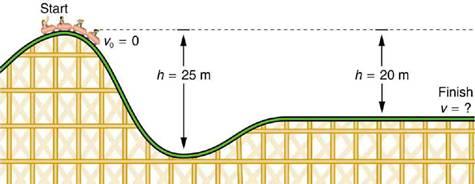In Example 7.7, we calculated the final speed of a roller coaster that descended 20 m in height and had an initial speed of 5
In Example 7.7, we calculated the final speed of a roller coaster that descended 20 m in height and had an initial speed of 5 m/s downhill. Suppose the roller coaster had had an initial speed of 5 m/s uphill instead, and it coasted uphill, stopped, and then rolled back down to a final point 20 m below the start. We would find in that case that it had the same final speed. Explain in terms of conservation of energy.
Example 7.7 Finding the Speed of a Roller Coaster from its Height
(a) What is the final speed of the roller coaster shown in Figure 7.8 if it starts from rest at the top of the 20.0 m hill and work done by frictional forces is negligible? (b) What is its final speed (again assuming negligible friction) if its initial speed is 5.00 m/s?

Figure 7.8 The speed of a roller coaster increases as gravity pulls it downhill and is greatest at its lowest point. Viewed in terms of energy, the roller-coaster-Earth system's gravitational potential energy is converted to kinetic energy. If work done by friction is negligible, all ![]() is converted to KE.
is converted to KE.
Strategy
The roller coaster loses potential energy as it goes downhill. We neglect friction, so that the remaining force exerted by the track is the normal force, which is perpendicular to the direction of motion and does no work. The net work on the roller coaster is then done by gravity alone. The loss of gravitational potential energy from moving downward through a distanc h equals the gain in kinetic energy. This can be written in equation form as ![]() . Using the equations for PEg and KE, we can solve for the final speed v, which is the desired quantity.
. Using the equations for PEg and KE, we can solve for the final speed v, which is the desired quantity.
Solution for (a)
Here the initial kinetic energy is zero, so that, ![]() The equation for change in potential energy states that
The equation for change in potential energy states that ![]() Since h is negative in this case, we will rewrite this as
Since h is negative in this case, we will rewrite this as ![]() to show the minus sign clearly. Thus,
to show the minus sign clearly. Thus,
![]() (7.34)
(7.34)
becomes
![]() (7.35)
(7.35)
Solving for v, we find that mass cancels and that
![]() (7.36)
(7.36)
Substituting known values,
 (7.37)
(7.37)
Solution for (b)
Again ![]() In this case there is initial kinetic energy, so
In this case there is initial kinetic energy, so ![]() Thus,
Thus,
![]() (7.38)
(7.38)
Rearranging gives
![]() (7.39)
(7.39)
This means that the final kinetic energy is the sum of the initial kinetic energy and the gravitational potential energy. Mass again cancels, and
 (7.40)
(7.40)
This equation is very similar to the kinematics equation ![]() but it is more general—the kinematics equation is valid only for constant acceleration, whereas our equation above is valid for any path regardless of whether the object moves with a constant acceleration. Now, substituting known values gives
but it is more general—the kinematics equation is valid only for constant acceleration, whereas our equation above is valid for any path regardless of whether the object moves with a constant acceleration. Now, substituting known values gives
 (7.41)
(7.41)
Discussion and Implications
First, note that mass cancels. This is quite consistent with observations made in Falling Objects that all objects fall at the same rate if friction is negligible. Second, only the speed of the roller coaster is considered; there is no information about its direction at any point. This reveals another general truth. When friction is negligible, the speed of a falling body depends only on its initial speed and height, and not on its mass or the path taken. For example, the roller coaster will have the same final speed whether it falls 20.0 m straight down or takes a more complicated path like the one in the figure. Third, and perhaps unexpectedly, the final speed in part (b) is greater than in part (a), but by far less than 5.00 m/s. Finally, note that speed can be found at any height along the way by simply using the appropriate value of h at the point of interest.
Start V, = 0 h = 25 m h = 20 m Finish V = ?
Step by Step Solution
There are 3 Steps involved in it
Step: 1
Answer Step by Step Explanation The expression to find ...
See step-by-step solutions with expert insights and AI powered tools for academic success
Step: 2

Step: 3

Ace Your Homework with AI
Get the answers you need in no time with our AI-driven, step-by-step assistance
Get Started


